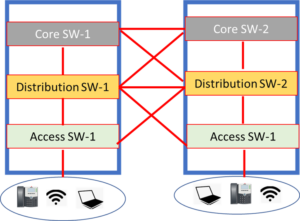During project implementation there are multiple stakeholders are involved at multiple stage and complete their task. As we all agree that being a project manager we need to interact, coordinate and track the all task progress with all stakeholders. To perform a implementation there are multiple tasks which are interdepend and next task can not be started until first task is not completed and that task is prerequisite for start that new task.
Some time to involve new team or vendor there are some other task which needs to completed by other vendor and other thing is Time. These all task should be completed on time. So, to avoid any gap a project manager should make a checklist for each and every tasks that needs to deliver.
Here, in this article we will discuss about IT network implementation check list.

Key point for Implementation
During implementation below are some key points which we needs to take care:
- All Core & Distribution devices should have redundant Power Supply’
- All Core and Distribution devices should have enough ports, modules and saleable.
- Should have 10, 25, 40 & 100G Fiber ports based on requirement.
- Solution should be redundant in terms of Hardware Level, Power Level, Link Level.
- All devices should be connected in cross-connection way
- End Users should not be terminated on single Switch.
- End-Devices should be distributed amonge all Switches.
- Need to take care about device Hot and Cold Air flow. Need to mount hardware as per their Air flow. If you have multiple Racks row ( Row-1, Row-2. Row-3)it is important to mount devices where all devices will have same side hot air flow.
-

Wrong Device Mounting 
Right Way of Mounting
Power Redundancy Setup:
How to connect Switch with Power strips with dual power supplies:
- Always prefer to have 2 power strips in network rack.
- Always recommended to have primary and secondary UPS power.
- Always consider core devices with dual power supply.
What should not be do:
- Don’t connect cores devices both power supply with single power strip, otherwise if power strip goes down than core devices will be powered off.
- If there is 2 power strips in a rack than don’t connect both power strips with single UPS power, otherwise it will again create single point of failure.
What should be recommended:
As shown in below diagram:
- Both power strips should be connected with 2 different UPS power source to create power redundancy.
Power Strip-2 —-> Primary UPS Power
Power Strip-1 —-> Secondary UPS Power
- In same manner core device power supply-1 should be connected with power strip-1 and power supply-2 with power strip-2.
Such kind of cross connectivity will create power redundancy at UPS level, power strip level and device level because if primary power source goes down then still core devices will have power from secondary source.

Device & Link Level Redundancy Setup:
Key recommendation to implement core and distribution devices to maintain hardware rack level, hardware level, link level redundancy.

As shown in above diagram:
- Always recommend to consider, budgeted and configure core and distribution devices as primary and secondary to maintain hardware level redundancy.
- We should not install both primary and secondary devices in same rack
- It’s recommended to install primary devices in rack-1 and secondary devices in rack-2 to maintain rack level redundancy.
- Don’t connect both primary and secondary devices with single uplink device and single uplink port to avoid single point of failure.
- It is recommended to maintain hardware and link level redundancy, we should connect all primary and secondary devices in cross connection fashion as shown in above diagram.
- From Rack-1 –> Core Switch-1 should be connected with Rack-2 –> Core Switch-2 to maintain HA.
- From Rack-1 –> 1 x uplink port should be connect with Core Switch-1 and other uplink port should be connect with Core Switch-2 at Rack-2.
- Same with Distribution Switch-2 from Rack-2 should be connected with Core Switch-2 and Core Switch-1.
- Both access switch should also connect in same cross connectivity fashion.
Such kind of connectivity will provide and maintain rack level, hardware level and link level redundancy because if whole Rack-1 or partially goes down due to any issue then still services will be continue from Rack-2 and vice-versa.
It will reduce service downtime and also will get time to troubleshooting breakdown rack/devices.
Also, for all critical services backup/redundancy based on business criticality we should keep backup and create DC, DR and NDR solution.
For end-user/access level devices like IP phones, access points, Thin clients, Video walls and other end-use devices should also not connected on single access switch or rack as shown in above diagram, these end-devices should also distributed with different access switches to maintain load balancing, in case one access switch goes down then only connected end-devices/services will be impacted, not whole network.
Conclusion
Mandatory checks are very important to avoid any gap like Power, Hardware delivery, active infra readiness, Passive Infra readiness, Customer approval, downtimes and team availability to perform that implementation.
Read More : https://techblog.kbrosistechnologies.com/
Visit to our site : https://www.kbrosistechnologies.com/
Watch more Video https://www.youtube.com/channel/UCpcd6IshE1caAbf9EdJd3gw

